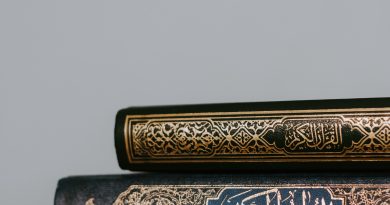How The Qur’an Describes Itself: Tafsir al-Sa’di
After a brief introduction, Sheikh ‘Abd al-Rahman al-Sa’di opened his book of thematic tafsir with the following chapter on the descriptions of the Qur’an found within the Qur’an itself:
ـ [مقدمة في ذكر أوصاف القرآن العامة الجامعة] ـ
Introduction: Some of the General Features of the Qur’an
في ذكر أوصاف القرآن العامة الجامعة قد وصف الله كتابه بأوصاف جليلة عظيمة تنطبق على جميعه، وتدل أكبر دلالة على أنه الأصل والأساس لجميع العلوم النافعة، والفنون المرشدة لخير الدنيا والآخرة: ـ
Allah has described His Book with many wonderful and tremendous qualities which apply to it in its entirety and which show with the utmost certainty that it is the foundation and the basis for all beneficial knowledge and all rightly-directed practices that lead to good in both this life and in the hereafter.
وصفه بالهدى والرشد، والفرقان، وأنه مبين وتبيان لكل شيء؛ فهو في نفسه هدى، ويهدي الخلق لجميع ما يحتاجونه من أمور دينهم ودنياهم، ويرشدهم إلى كل طريق نافع، ويفرق لهم بين الحق والباطل، والهدى والضلال، وبين أهل السعادة والشقاوة بذكر أوصاف الفريقين، وفيه بيان الأصول والفروع بذكر أدلتها النقلية والعقلية، فوصفه بهذه الأوصاف المطلقة العامة التي لا يشذ عنها شيء في آيات كثيرة. ـ
He described it as “a guidance”, “right direction,” “a criterion”, and that it is clear and a clarification for everything. So it is in-and-of-itself guidance, and it guides the created beings to everything that they need in terms of both their religion and their worldly lives and it directs them to every beneficial path. It shows them the difference between truth and falsehood, between guidance and misguidance, and between the people of ultimate joy and the people of ultimate sorrow through mentioning the qualities of these two groups.
It contains a explanation of both fundamental principles and secondary matters, mentioning evidences both of textual and intellectual natures for these. So Allah characterized the Qur’an completely and unrestrictedly with these qualities, and none of its many ayaat fall outside of these descriptions.
وقيد هدايته في بعض الآيات بعدة قيود: قيد هدايته بأنه هدى للمؤمنين المتقين؛ لقوم يعقلون، ويتفكرون، ولمن قصده الحق، وهذا بيان منه تعالى لشرط هدايته؛ وهو أن المحل لا بد أن يكون قابلا وعاملا، فلا بد لهدايته من عقل وتفكير وتدبر لآياته؛ فالمعرض الذي لا يتفكر ولا يتدبر آياته لا ينتفع به، ومن ليس قصده الحق ولا غرض له في الرشاد، بل قصده فاسد، وقد وطن نفسه على مقاومته ومعارضته، ليس له من هدايته نصيب؛ فالأول حرم هدايته لفقد الشرط، والثاني لوجود المانع؛ فأما من أقبل عليه، وتفكر في معانيه وتدبرها بحسن فهم، وحسن قصد، وسلم من الهوى، فإنه يهتدي به إلى كل مطلوب، وينال به كل غاية جليلة ومرغوب. ـ
In some ayaat, Allah qualified His guidance within a number of parameters. He qualified it as being guidance for the believers, for those with taqwa, for people who have reason, for those who think, and for those who desire the truth. So this is Allah giving us an explanation of the conditions that must be in place for one to receive His guidance. That is that the one receiving His guidance must accept it and act according to it, and must have reason and thoughtfulness, and must ponder over His ayaat.
But those who turn away from guidance, neither reflecting nor pondering over His ayaat, nor benefiting from them, or those who do not desire the truth or want right guidance but instead desire corruption, those who made their camp on resisting and opposing the truth – then there is no portion of Allah’s guidance for such people.
The one who turns away from guidance was deprived of Allah’s guidance due to lacking a necessary prerequisite for guidance.
Meanwhile, the one who does not want the truth was deprived due to the presence of something which would prevent that guidance.
But as for a person whose takes in interest in Allah’s guidance, who reflects over its messages and contemplates them with good understanding and good intentions, and who is free from lowly desires, then he will be guided to every desirable thing and attain every sought-after goal through it.
ووصفه بأنه رحمة، وهي الخير الديني والدنيوي والأخروي المترتب على الاهتداء بالقرآن، فكل من كان أعظم اهتداء به فله من الرحمة والخير والسعادة والفلاح بحسب ذلك. ـ
Allah also described the Qur’an as “rahmah” – mercy -. Rahmah is any goodness in the religion, in the worldly life, and in the hereafter, all of which comes from the guidance of the Qur’an. So whenever a person increases his level of being guided by the Qur’an, then his share of rahmah, goodness, happiness, and success will also increase in step with that.
ووصفه بأنه نور، وذلك لبيانه وتوضيحه العلوم النافعة، والمعاني الكاملة، وأن به يخرج العبد من جميع الظلمات: ظلمات الجهل والكفر والمعاصي والشقاء، إلى نور العلم واليقين والإيمان والطاعة والرشاد المتنوع. ـ
Allah also described the Qur’an as “light”. That is because it clarifies and elucidates the beneficial knowledge and perfect messages. It is also described as light because through it the slave can emerge from the various forms of darkness – the darknesses of ignorance, of disbelief, or sinfulness, of sorrow – and enter into the light of knowledge, certainty, eemaan, obedience, and the various forms of right guidance.
ووصفه بأنه شفاء لما في الصدور، وذلك يشمل جميع أمراض القلوب؛ فهو يوضح أمراض القلوب ويشخصها، ويرشد العباد إلى كل وسيلة يحصل بها زوالها وشفاؤها، فيذكر لهم أمراض الجهل والشكوك والحيرة وأسباب ذلك، ويرشدهم إلى قلعها بالعلوم النافعة واليقين الصادق، وسلوك الطرق الصحيحة المزيلة لهذه العلل، ويذكر لهم أمراض الشهوات والغي، ويبين لهم أسبابها وعلاماتها وآثارها الضارة، ويذكر لهم ما به تعالج من المواعظ والتذكر والترغيب والترهيب، والمقابلة بين الأمور، وترجيح ما ترجحت مصلحته العاجلة والآجلة. ـ
Allah also describes the Qur’an as “a healing for what is in the chests”, and that includes all types of sicknesses of the hearts, for the Qur’an clearly identifies and diagnoses all the sickness of the heart, and it guided the slaves to every means through which these diseases could be removed and cured. Allah mentions the sickness of ignorance, doubt, confusion and the causes behind these things, and He directs the people as to how to remove these illnesses by means of beneficial knowledge, true certainty, and traversing the correcting path which eliminates these defects. He also mentions the diseases of lowly-desires and crookedness, as well as explaining their causes, their signs, and their harmful effects. He also mentions exhortations, reminders, encouragements and intimidations which can treat these illness. He uses all of these things together in different combinations, and He compares the different options available to us so as show what is truly of benefit both in the short term and the long term.
ووصفه بأنه كله محكم، وكله متشابه في الحسن، وبعضه متشابه من وجه، محكم من وجه آخر. فأما وصفه في عدة آيات أنه كله محكم، فلبلاغته وبيانه التام، واشتماله على غاية الحكمة في تنزيل الأمور منازلها، ووضعها مواضعها، وأنه متفق غير مختلف، ليس فيه اختلاف ولا تناقض بوجه من الوجوه. ـ
Allah also describes the Qur’an as being completely muhkam, and completely mutashaabih in a good way, as well as parts of it being mutashaabih from a certain angle and part of it being muhkam from a different angle.
As for Allah describing the entire Qur’an as being muhkam [perfect] in a number of ayaat, this is because of its linguistic eloquence, its complete clarity, its containing the utmost wisdom in terms of its ordering and arrangement, and that it is completely cohesive and consistent without containing any conflict or contradictions in any shape or form.
وأما حسنه فلما فيه من البيان التام لجميع الحقائق، ولأنه بين أحسن المعاني النافعة في العقائد والأخلاق والآداب والأعمال، فهي في غاية الحسن لفظا ومعنى، وآثارها أحسن الآثار، وكل هذه المعاني المثناة في القرآن يشهد بعضها لبعض في الحسن والكمال، ويصدق بعضها بعضا. ـ
As for its excellence, it is characterized as such because of the complete explanation of every thing that it contains, and because it clearly states the best of beneficial meanings regarding beliefs, manners, etiquettes, and actions. So the Qur’an is the apex of goodness both in its wordings and meanings, and its effects are the best of effects. And all of its messages which are repeated and reiterated throughout the Qur’an support one another in goodness and perfect and affirm one another’s truthfulness.
وأما وصفه بأن منه آيات محكمات هن أم الكتاب، وأخر متشابهات، فالمتشابهات هي التي يقع الإشكال في دلالتها لسبب من الأسباب اللفظية والعبارات المركبة، فأمر الله بردها إلى المحكمات الواضحة، بينة المعاني، التي هي نص في المراد؛ فإذا ردت المتشابهات إلى المحكمات صارت كلها محكمات، وزال الشك والإشكال، وحصل البيان للهدى من الضلال. ـ
As for Allah’s description of the Qur’an as:
مِنْهُ آيَاتٌ مُّحْكَمَاتٌ هُنَّ أُمُّ الْكِتَابِ وَأُخَرُ مُتَشَابِهَاتٌ
It includes muhkam ayaat – these are the basis of the Book – and other ayaat which are mutashaabih [3:7]
The mutashaabih portions are those which allow for some confusion in terms of what they mean as a result of various causes related to their wordings or phrasings. So Allah commanded us to refer these mutashaabih ayaat back to the clear muhkam ayaat which clarify what meanings were actually intended. So if the mutashaabih ayaat are referred back to the muhkam ayaat for clarification, then the entire Qur’an becomes muhkam and any confusion or doubt is elimated, resulting in a clear distinction between guidance and misguidance.
ووصفه بأنه كله صلاح، ويهدي إلى الإصلاح، وإلى أقوم الأمور وأرشدها وأنفعها في كل شيء من دون استثناء، وهذا الوصف المحيط لا يخرج عنه شيء، فهو إصلاح للعقائد والقلوب، وللأخلاق والأعمال، ويهدي إلى كل صلاح ديني ودنيوي بحيث تقوم به الأمور، وتعتدل به الأحوال، ويحصل به الكمال المتنوع من كل وجه بالإرشاد إلى كل وسيلة نافعة تؤدي إلى المقاصد والغايات المطلوبة، فلا سبيل إلى الهداية والصلاح والإصلاح لجميع الأمور إلا بسلوك الطرق التي أرشد إليها القرآن، وحث العباد عليها. ـ
Allah also describes the entire Qur’an as being upright and that it leads to rectitude, to the most upright, rightly-guided, and beneficial of matters in every circumstance without any exceptions.
And this description is all-encompassing with no exceptions, for the Qur’an is a source of rectification for one’s beliefs and heart, for one’s manners and actions, and it guides to the rectitude of both one’s religion and worldly life. It is through the Qur’an that one sets their affairs aright, is balanced in all circumstances, and attains all forms of completeness in every area through taking the guidance to every beneficial means that conducts one to the desired outcomes and objectives. There is no way to guidance, rectitude, and uprightness in all of one’s affairs other than traversing the routes which the Qur’an directs us and encourages us to take.
فمتى عرفت أن القرآن العظيم موصوف كله بهذه الأوصاف التي هي أعلى الأوصاف وأكملها وأتمها وأنفعها للعباد، وأنه أعيدت فيه هذه المعاني الجليلة، ومزجت فيه مزجا عجيبا غريبا في كماله وحسنه، فهمت أن طالب العلم إذا وقف على تفسير بعض الآيات تدرب بها، وتوسل بها إلى معرفة بقية الآيات. ـ
So once you realize that the entire Qur’an is characterized by these highest, most complete, perfect and beneficial features, and that it repeats and reiterates its wonderful messages and blends them in such a wonderful and unique mixture, then you will understand that the if the seeker of knowledge comes to know the explanation of certain ayaat, he becomes familiar with them and can use them to gain an understanding of other ayaat.
لهذه الأسباب وغيرها رأينا أن المصلحة تدعو إلى الاقتصار على خلاصة ذلك التفسير؛ راجين من الرب أن يتم نعمته، وأن يحصل به المقصود؛ ورأينا أن الأحسن أن نذكر كل موضوع على حدته، لما فيه من التقريب والسهولة وجمع المعاني التي من فن واحد في موضع واحد؛ مع أنه – كما تقدم – لا بد أن يدخل في آيات الأصول كثير من الفروع، وفي آيات الفروع كثير من الأصول، ويدخل فيها من الترغيب والترهيب والقصص شيء كثير؛ وهذا المزج العجيب من كمال القرآن وعظم تأثيره، فإنه كتاب تعليم يزيل الجهالات المتنوعة، وكتاب تربية يقوم الأخلاق والأعمال، فهو يعلم ويقوم ويهذب ويؤدب بأعلى ما يكون من الطرق، التي لا يمكن للحكماء والعقلاء أن يقترحوا مثلها، ولا ما يقاربها. ـ
So because of these and other reasons, I saw an overall benefit to producing a summary of those explanations, hoping that my Lord would complete that favor of His and that I could thereby achieve this goal of mine. And I thought that it would be best if I would mention each topic in a section of its own, seeing as this might make it more appealing to readers and easy to digest, and that I would gather the content pertaining to each subject in its own place.
This is despite what I have already mentioned above that many secondary issues branch off from the ayaat that are central to each topic, and that many fundamental principles can be found in the ayaat pertaining to secondary rulings, and that many examples of encouragements, intimidations, and stories are also like this. This amazing blend of different features is part of the Qur’an’s perfection and its tremendous effect on its readers. For it is book of teaching which removes the various types of ignorance, and it is a book of good upbringing which cultivates one’s manners and deeds. So it teacher, cultivates, refines, and disciplines through the loftiest of methods, such that the sages and intellectuals cannot put forward anything like it, or even anything close.
[Taysir al-Lateef al-Mannaan pg. 23-26]
Continue to the next chapter of Imam al-Sa’di’s thematic tafsir here: Tafsir of Surah al-Fatihah: Imam al-Sa’di
If Allah allows, it is a long-term goal to translate this entire work. Significant portions have already been translated and published on this website at the time of this article’s publication, which you can explore here. We ask for Allah’s assistance to complete the book.
See also: Guidance for Interpreting the Qur’an in Surah Aal ‘Imran: Tafsir ibn Kathir
See also: How the Qur’an Uses Contrasting Pairs and Repetition: Tafsir ibn Kathir
See also: The Meanings of Muhkam, Mutashaabih, and Ta’weel: al-Lajnah al-Daa’imah
See also: The Wisdom of Dividing the Qur’an into Muhkam and Mutashaabih Verses: Ibn ‘Uthaymeen
See also: Six Basic Guidelines for Understanding the Qur’an: Imam al-Sa’di




